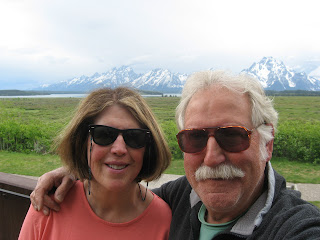
Happy stayed home for our winter trip to Jackson Hole. Just driving was enough of a challenge, with snow falling as we crested the Sierras and 18-wheelers throwing up blinding sheets of slush on the windshield. This trip was more about snow, hot tubs and martinis than camping, but wildlife viewing is always our goal.
As we approached Jackson from the south, we spotted a few pronghorn antelope, driven out of their northern feeding grounds by the snow, their slender legs incapable of moving through the deep drifts. Deer browsed near the road, including a buck with an impressive rack. A bald eagle surveyed the landscape from a fence post and a golden eagle fed on roadkill.
It was early in the snow season, and the elk had only recently begun moving from the hills into the 25,000-acre refuge, established in 1912 to provide elk with a protected winter feeding ground. Last winter, elk in the refuge numbered 6,000.
There were fewer than 100 in residence as we rattled and bounced in a sleigh pulled by a pair of hefty Belgian draft horses, frisky at their first day out on the range. The Belgians were brother and sister, and they clearly adored each other, nuzzling whenever the driver pulled up on the reins.
Although the skittish elk take off at the sight of humans, horses can approach with impunity and we came very close to a small herd of bulls, contently chewing their cuds. The fall rut over, elk once again grouped by gender, the males having lost a quarter of their body weight in the rigors of wooing females. Like the moose we saw later, they conserved energy by spending much of the day lying down.
Low-hanging clouds obscured the mountains and for the first time ever, we saw no bison on their customary range along Antelope Flats road. Only birds were visible: black and white magpies, both sage and ruffled grouse, and a mob of ravens feeding on the grass-filled gut of a slain elk.
A howling chorus of coyotes greeted us our first evening, and we spotted prints of a red fox in the snow near our door, but never saw either.
While common animals were scarce, we came across a herd of the less-common bighorn sheep, driven down from the rocky heights by swirling winds. I snapped pictures until my fingers were numb as they browsed nonchalantly along the road, literally moving within touching distance.
The sound of – band practice? – stopped us on a quiet road another day and we found we’d discovered a winter refuge for trumpeter swans, impressive birds with eight-foot wingspreads and a call that sounds like a musical instrument.
In another month, the elk refuge would be filled with elk and the bison who compete for their food. On occasion, they’ll be joined by wolves from the new packs recently formed in Grand Teton Park.
Of the wolves we’ve been watching up in Yellowstone’s Lamar Valley, there was news. The lone black pup we saw mousing last fall had not survived, nor had a second pup. Of 9 or 10 pups born to the fabled Druid Peak pack last spring, none were alive to see the winter. Even more ominous for the pack’s future was the death of 569, the handsome gray matriarch and alpha female of the pack, killed by other wolves. Her sister, mother of some of the pups born this spring, has not been seen for months. Will the remaining Druid adults, coats thinned by mange, survive the bitterly cold winter? Will the now all-male pack find females to court? We’ll find out next spring.
Follow link below for photos:
http://picasaweb.google.com/happytwo.mcwilliams/JacksonHoleDec2009?authkey=Gv1sRgCPXIo6DKoeeJZQ&feat=directlink










